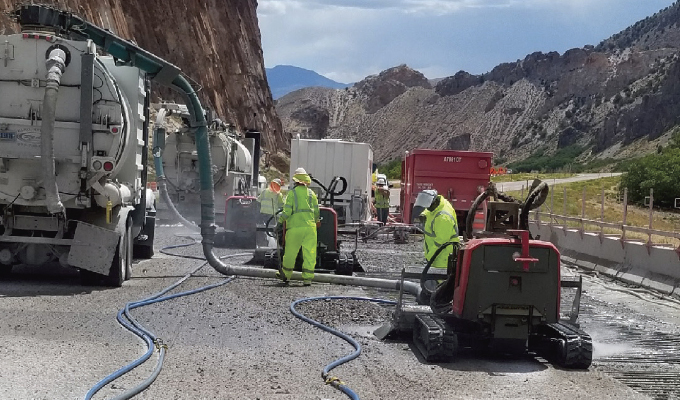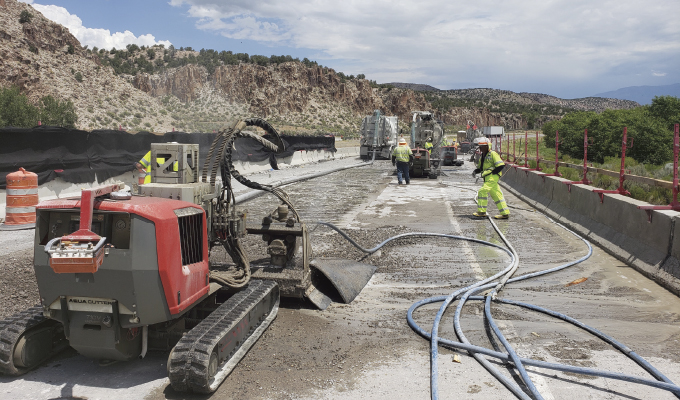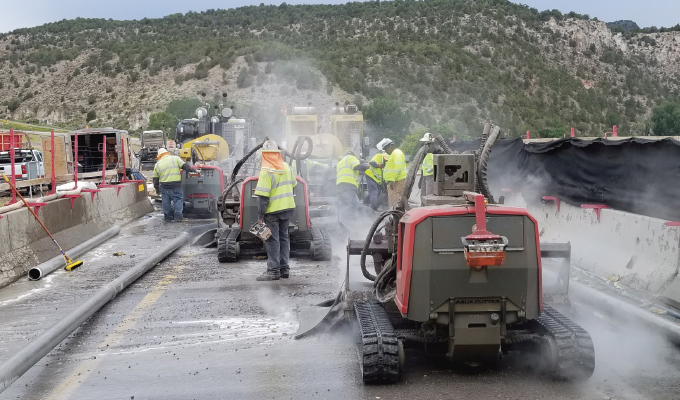Robots speed up Utah’s largest hydrodemolition project
In an effort to complete jobs faster and win more bids, contractors are always looking for ways to speed up their processes while spending less. A hydro-blasting contractor working on a large bridge rehabilitation project underway in Utah is having success using a unique technique that fits the bill.
20-MILE PROJECT
When Utah Department of Transportation (UDOT) officials noticed a number of bridges on I-70 between Cove Fort and Sevier with bridge decks showing signs of significant wear, they started the process of updating them. The 20-mile project includes replacing the deck concrete on 14 parallel bridges to extend the life of the structures and provide an improved driving surface.
UDOT hired W.W. Clyde & Co. as the project’s general contractor. The company is a heavy civil construction firm based out of Orem, Utah. W.W. Clyde then hired Lyman, Wyoming-based Redi Services for the bridge concrete removal portion. The contractor provides a number of services, with a focus on hydro-blasting.

The project was set to begin in April 2018 and be finished by the end of 2019. For this to happen, W.W. Clyde carefully choreographed the plan for maximum efficiency. This meant a critical path with little downtime built-in and contractors rapidly moving in to complete work as soon as the previous step in the project was finished. Redi Services was tasked with the first step, removing the top half of the 8-inch concrete bridge deck.
A NEW METHOD
A highly efficient technique would be needed in order to remove concrete from 14 bridges in such a short span of time. UDOT officials conducted a study in 2016 and 2017 to determine what treatment could be used. They found the bridge deck damage was so great that the traditional method of pothole patching wouldn’t be enough. As a result, UDOT officials decided on a less traditional method: removing concrete with hydrodemolition. The study found that using the technique would cost an estimated $14.4 million compared to $29.7 million to reconstruct the bridge decks and $300 million to replace the bridges entirely. The technique would also speed up the project, significantly reducing the number of days traffic would be impacted. The report also found that hydrodemolition would give the bridge decks a life expectancy boost similar to a bridge deck replacement. UDOT officials say they anticipate hydrodemolition will extend the bridge decks’ lives by as much as 25 years.
HYDRODEMOLITION ON I-70
Redi Services kicked off the I-70 project in April 2018 at the bridge above Clear Creek Canyon Road just east of Cove Fort. Work would continue east from there. It would be Utah’s largest hydrodemolition bridge deck project.
Armed with four Aquajet Aqua Cutter 710 robots rented from Jetstream, a Houston-based hydrodemolition equipment rental specialist, the contractor got to work. It wouldn’t be as easy as simply blasting away the concrete and letting the water and concrete debris flow away, however. UDOT set environmental protection as a No. 1 priority and some of the bridges spanned Class A waterways, contamination of which could mean heavy fines and loss of eligibility to work on future government projects. Redi Services needed to retrieve all of the debris and used water, as well as recycle as much as possible.
To do this, the contractor set in place an efficient system of hydrodemolition, debris and water collection, filtration, and reuse. Operators use three robots simultaneously, with one serving as a backup in case of a breakdown. Crews direct Aqua Cutters spaced about 20 feet apart to remove 4 inches of the 8-inch bridge deck concrete with 20,000 psi water jets, leaving one inch between the remaining concrete and the rebar. Together, the robots remove about 60 cubic yards of concrete a day. Each machine jets about 24,000 gallons of water per 10-hour shift.
WATER USE RECYCLED
To prevent the gray water from escaping, crews dam up the storm collection box on the downhill end of the bridges, as well as any areas fugitive water could leak. The spent water flows to the collection area where Vactor, Tornado and Guzzler vacuum trucks suck it up. Truck operators also follow the robots to remove as much standing water as possible and prevent it from evaporating and leaving concrete dust in the frequent 90-degree heat.

The vacuum trucks then send the used water through filtration equipment developed by Redi Services, Adler Tank Rentals and W.W. Clyde. The system processes 150 gallons a minute, first allowing debris to settle in a frac tank, then filtering the water, then conducting pH treatment. The cycle continues until the water is clean, at which point it is dumped into a 21,000-gallon storage tank to be used by the robots again. Crews haul any water that couldn’t be reused to a settling pond, but the contractor says this has only been about 10,000 gallons while 180,000 gallons have been reused. Crews haul the concrete debris to a concrete plant to be recycled.
FINISHING TOUCH
Workers follow with handheld breakers to even out any high spots after robots complete a section. Following concrete removal, crews spray the surface with pressure washers or fire hose to wash away any remaining debris. After that, workers use sandblasters to remove any remaining rust from the rebar. Finally, the contractor uses blowers to blow the sand off of the concrete and rebar to one end of the bridge where it can be collected.
To protect workers, traffic, and nearby structures, Redi Services installs 8-foot-tall barriers around the work zone in the event any concrete bits escape and fly hundreds of feet. Crews also added extra rubber around the water jets.
Following Redi Services’ concrete removal, the next contractor pours bridge deck concrete and lets it sit for 10 to 15 days. The last part of the critical path is a fresh asphalt overlay. As these steps are completed, Redi Services moves on to the next bridge.
As of August 2018, Redi Services had completed nine bridges and Austin says the contractor expects to wrap up its portion of all 14 in spring 2019. Total project completion is scheduled for late 2019. By the time the project is over, the contractor will have saved an estimated 1 million gallons of water as a result of recycling, equal to about 63 below-ground backyard swimming pools. Workers will have removed about 3,300 cubic yards of concrete, most of which will also be recycled.
CLOSING THOUGHT
“Hydroblasting contractors used to have a reputation for being wasteful and not doing much to catch and treat the wastewater,” says Cody Austin, Redi Services Nevada area manager. “UDOT officials impressed with our collection and recycling efforts tell us they expect there will be a lot more hydrodemolition jobs on the horizon.”
For more information
Redi Services is an industrial service support company headquartered in Lyman, Wyoming. For more information, visit www.rediservicesllc.com. Aquajet Systems is known as the industry leader in hydrodemolition machines and solutions. Brokk Inc. represents Aquajet in the U.S. For more information, visit www.brokk.com.
Modern Contractor Solutions, September 2019
Did you enjoy this article?
Subscribe to the FREE Digital Edition of Modern Contractor Solutions magazine.



